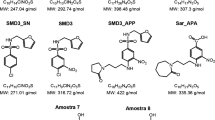Summary
-
1.
Voltage clamp experiments were done on single myelinated nerve fibres of the frog,Rana esculenta.
-
2.
53 μM 4-aminopyridine (4-AP) reducedI K to about one-fifth if tested with infrequent (1/min) and short (10 ms) depolarizing pulses; the onset time constant under these circumstances was ca. 160 s (14–15° C). After prolonged treatment the effect was virtually irreversible.
-
3.
At equilibrium with 4-AP, increasing the frequency of short pulses removed part of the block, the block removal accelerating with inceasing pulse duration and frequency.
-
4.
In 53 μM 4-AP unblocking of K channels during long (0.8 s) depolarizing pulses proceeded with a time constant, τ r , of ca. 0.2 s. Restoration of block at the resting potential proceeded with a much larger time constant, τ′ r , of ca. 1 min.
-
5.
The stationary fraction,r ∞, of K channels conducting in 53 μM 4-AP was 0.66, 0.41, and 0.24 at V=120, 50, and 0 mV, respectively.
-
6.
In a series of experiments with [4-AP] varying between 13.3 and 848 μM, τ r decreased from 0.25 to 0.10 s (V=130 mV, ca. 17°C) whiler ∞ followed the empirical relation 1/r ∞=1+c t +c v exp(−0.77 EF/RT) with E=V-70 mV.c t andc v are dimensionless quantities that increase with [4-AP] and reflect the voltage-independent and voltage-dependent component, respectively, of block.
-
7.
Block of K channels and partial removal are also observed with inwardI K at raised [K+]0. Removal proceeds on depolarization even ifI K is additionally but temporarily suppressed by tetraethylammonium. Hence neither direction nor amplitude ofI K but only the pulse potential seems to determine the extent of block for a given [4-AP].
Similar content being viewed by others
References
Albert, A., Goldacre, R., Phillips, J.: The strength of heterocyclic bases. J. chem. Soc.1948, 2240–2249
Bergman, C., Stämpfli, R.: Différence de perméabilité des fibres nerveuses myélinisées sensorielles et motrices à l'ion potassium. Helv. physiol. pharmacol. Acta24, 247–258 (1966)
Christen, D., Norbury, D., Lister, D. G., Palmieri, P.: Microwave spectra and structure of the amine group in 3-aminopyridine and 4-aminopyridine. J. chem. Soc. Faraday Trans. II71, 438–446 (1975)
Frankenhaeuser, B.: Delayed currents in myelinated nerve fibres ofXenopus laevis investigated with voltage clamp technique. J. Physiol. (Lond.)160, 40–45 (1962)
Frankenhaeuser, B.: A quantitative description of potassium currents in myelinated nerve fibres ofXenopus laevis. J. Physiol. (Lond.)169, 424–430 (1963)
Frankenhaeuser, B., Hodgkin, A. L.: The after-effects of impulses in the giant nerve fibre ofLoligo. J. Physiol. (Lond.)131 341–386 (1956)
Frankenhaeuser, B.,Huxley, A. F.: The action potential in the myelinated nerve fibre ofXenopus laevis as computed on the basis of voltage clamp data. J. Physiol. (Lond.)171, 302–315 (1964)
Gillespie, J. I., Hutter, O. F.: The actions of 4-aminopyridine on the delayed potassium current in skeletal muscle fibres. J. Physiol. (Lond.)252, 70–71P (1975)
Hille, B.: The selective inhibition of delayed potassium currents in nerve by tetraethylammonium ion. J. gen. Physiol.50, 1287–1302 (1967)
Hille, R.: Potassium channels in myelinated nerve: selective permeability to small cations. J. gen. Physiol.61, 669–686 (1973)
Koppenhöfer, E.: Die Wirkung von Tetraäthylammoniumchlorid auf die Membranströme Ranvierscher Schnürringe von Xenopus laevis. Pflügers Arch. ges. Physiol.293, 34–55 (1967)
Meves, H., Pichon, Y.: Effects of 4-aminopyridine on the potassium currents in internally perfused giant axons of the squid. J. Physiol. (Lond.)251, 60–61P (1975)
Meves, H., Pichon, Y.: The effect of internal and external 4-aminopyridine on the K currents in intracellularly perfused squid giant axons. Proc. roy. Soc. B (in press, 1976)
Nonner, W. A new voltage clamp method for Ranvier nodes. Pflügers Arch.309, 176–192 (1969)
Pelhate, M., Pichon, Y.: Selective inhibition of potassium current in the giant axon of the cockroach. J. Physiol. (Lond.)242, 90–91 P 1974)
Pelhate, M., Hue, B., Pichon, Y., Chanelet J.: Action de la 4-amino-pyridine sur la membrane de l'axone isolé d'Insecte. C. R. Acad. Sci. (Paris)278 Ser. D, 2807–2809 (1974)
Schwarz, J. R., Vogel, W.: Potassium inactivation in single myelinated nerve fibres of Xenopus laevis. Pflügers Arch.330, 61–73 (1971)
Smith, M. E., Smith, L. E.: Piperazine dihydrochloride and glycylglycine as non-toxic buffers in distilled and in sea water. Biol. Bull.96, 233–237 (1948)
Strichartz, G. R.: The inhibition of sodium currents in myelinated nerve by quaternary derivatives of lidocaine. J. gen. Physiol.62, 37–57 (1973)
Ulbricht, W.: Effect of temperature on the slowly changing sodium permeability of veratrinized nodes of Ranvier. Pflügers Arch.311, 73–95 (1969)
Vierhaus, J., Ulbricht, W.: Rate of action of tetraethylammonium ions on the duration of action potentials in single nodes of Ranvier. Pflügers Arch.326, 88–100 (1971)
Wagner, H.-H., Ulbricht, W.: 4-aminopyridine block of K channels and its partial relief on depolarization. Abstr. 5th Int. Biophys. Congr. 1975, p. 138 (1975a)
Wagner, H.-H., Ulbricht, W.: The rates of saxitoxin and of saxitoxin-tetrodotoxin interaction at the node of Ranvier. Pflügers Arch.359, 297–315 (1975b)
Wagner, H.-H., Ulbricht, W.: Voltage-dependent block of K channels by 4-aminopyridine. Pflügers Arch.362, R31 (1976)
Woodhull, A. M.: Ionic blockage of sodium channels J. gen. Physiol.61, 687–708 (1973)
Yeh, J. Z., Oxford, G. S., Wu, C. H., Narahashi, T.: Interactions of aminopyridines with potassium channels of squid giant axon membranes. Biophys. J.16, 77–81 (1976)
Author information
Authors and Affiliations
Additional information
Supported by the Deutsche Forschungsgemeinschaft
Rights and permissions
About this article
Cite this article
Ulbricht, W., Wagner, H.H. Block of potassium channels of the nodal membrane by 4-aminopyridine and its partial removal on depolarization. Pflugers Arch. 367, 77–87 (1976). https://doi.org/10.1007/BF00583659
Received:
Issue Date:
DOI: https://doi.org/10.1007/BF00583659




